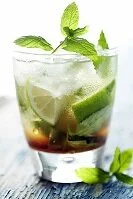Regional Variations, Specialties, & Unique Dishes
Ackee & Saltfish: unofficially the national dish, it is salted cod, ackee (a fruit), onions, tomatoes, and spices
Dining Etiquette
Generally speaking, dining in Jamaica is an informal affair, but some nice restaurants, and for business you should still dress up and bring your best etiquette. No matter the occasion though, the Jamaicans are quite forgiving of cultural mishaps and dining mistakes, but do your best to follow their protocol.
Arrive on time to meals and let your host seat you. There are seating rules, especially in homes and often times couples will be separated to encourage greater conversation. Your meal may begin with a drink and the word "cheers," or it may simply begin with the food, but again your host will indicate when you may begin eating. Once you begin eating, it is considered rude to leave the table for any reason.
If in a home you are expected to try everything offered, but food is usually served family style so you may take less of anything that may not be as appetizing to you. As you eat, use the continental style (knife in the right hand, fork in the left); if you wish, you may put your fork and knife on your plate and rest your hands on your lap. However, if you put your fork and knife down together on the right side of your plate it indicates that you have finished eating. Before you do that, try to finish all the food on your plate.
If dining in a restaurant, the inviter is expected to pay for everyone present and should turn down all offers to pay, an offer you should make if you're the guest. In most restaurants the tip is also included in the bill, but if not a tip of 10% is appropriate.
Celebrations & Events
Jamaica has a number of holidays, but few of them are truly associated with particular foods or drinks other than the festivals specifically focused on a particular food. However, there are a huge number of celebrations that are wholly dedicated to a single food and these are the best time to try these foods in more ways than you thought possible. There is a Mango Festival, Breadfruit Festival, Yam Festival, Jerk Festival, Chicken Festival, and more. If you have a chance to attend one of these, there is no doubt you'll get to try local dishes along with some cultural experiences as well.
Drinks

Mojito
No matter the beverage you're looking for, Jamaica will likely have it as tea, coffee, milk, soft drinks, and juices are all available. They are best known for their juices though and these are the most accessible drinks on the island as juices range from mango and passion fruit to carrot.
Among the alcoholic drinks, again nearly everything is available but few alcoholic beverages are made locally. Rum and beer are the most commonly consumed alcoholic drinks on the island. For a twist on an international favorite, try the "Guinness punch," which is a mixture of Guinness beer with nutmeg and vanilla.
The tap water is generally safe to drink in Jamaica, but in many areas, particularly rural areas, it might not be safe. The most cautious course of action is to entirely avoid the tap water and items that could be made from or with the water, such as ice, fruits, and salads. If you do decide to drink the local tap water, first check with your local hotel or guesthouse to learn the cleanliness of the water in that area. If the water is safe, remember that many people may have trouble adjusting to the local tap water as it will most certainly be different from what your system is used to if you are not from the region.